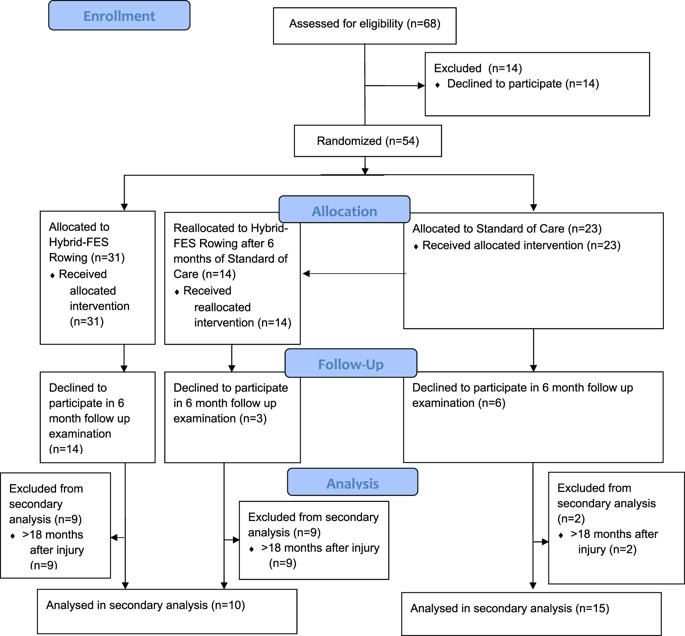Spinal Cord ( IF 2.2 ) Pub Date : 2020-02-24 , DOI: 10.1038/s41393-020-0445-3 Raymond C Chou 1 , J Andrew Taylor 1 , Ryan Solinsky 1

|
Study design
Secondary outcome measures analysis of a randomized, controlled study.
Objective
To assess the effects of hybrid-functional electrical stimulation (FES) rowing on motor and sensory recovery in individuals with spinal cord injury (SCI) 6–18 months post injury.
Setting
Outpatient rehabilitation network.
Methods
25 participants 6–12 months after SCI were randomly assigned to hybrid-FES rowing (n = 10) or standard of care (n = 15) groups. The hybrid-FES rowing group completed 6 months of rowing scheduled 3 times per week for 26 weeks at an exercise intensity of 70–85% of maximal heart rate. The standard of care group either participated in an arm ergometer exercise program (n = 6) or a waitlist without an explicit exercise program (n = 9). Changes in motor score and combined sensory score of the International Standards for Neurological Classification of SCI (ISNCSCI) were analyzed.
Results
Both groups demonstrated increases in motor and combined sensory scores, but no significant differences were noted between intervention groups (motor difference mean ↑1.3 (95% CI, −1.9 to 4.4), combined sensory difference mean ↓10 (−30 to 18)). There was an average of 63% adherence to the hybrid-FES rowing protocol, with no significant correlation in changes in motor or combined sensory score in the hybrid-FES rowing group with total distance or time rowed.
Conclusions
No significant effects to neurologic improvement were found with hybrid-FES rowing when compared with standard of care interventions in individuals with SCI 6–18 months post injury.
中文翻译:

混合功能电刺激(FES)划船全身运动对亚急性脊髓损伤神经系统改善的影响:一项随机对照试验的次要结果分析。
学习规划
次要结局指标是对一项随机对照研究的分析。
目的
评估混合功能电刺激(FES)划船对受伤后6-18个月有脊髓损伤(SCI)的个体运动和感觉恢复的影响。
设置
门诊康复网络。
方法
SCI后6-12个月的25名参与者被随机分配到混合FES划船(n = 10)或护理标准(n = 15)组。混合式FES划船组以最大心率的70–85%的运动强度,每周完成3个月的6个月划船,共26周。护理标准组要么参加了臂力计锻炼计划(n = 6),要么参加了没有明确锻炼计划的候补名单(n = 9)。分析了国际SCI神经分类标准(ISNCSCI)的运动评分和综合感觉评分的变化。
结果
两组均表现出运动和综合感觉评分的提高,但干预组之间未发现显着差异(运动差异平均值为↑1.3(95%CI,-1.9至4.4),综合感觉差异平均值为↓10(-30至18)) 。混合FES划船方案的平均遵守率为63%,而混合FES划船组的运动或综合感觉评分的变化与总距离或划船时间之间没有显着相关性。
结论
与标准的护理干预相比,混合FES划船对受伤后6-18个月的SCI患者没有明显改善神经系统的作用。



























 京公网安备 11010802027423号
京公网安备 11010802027423号